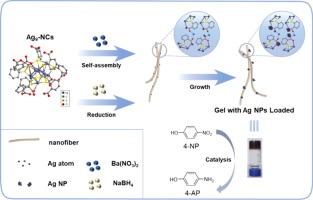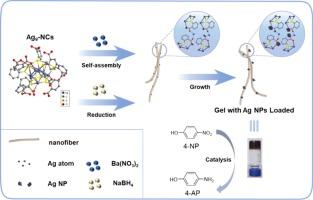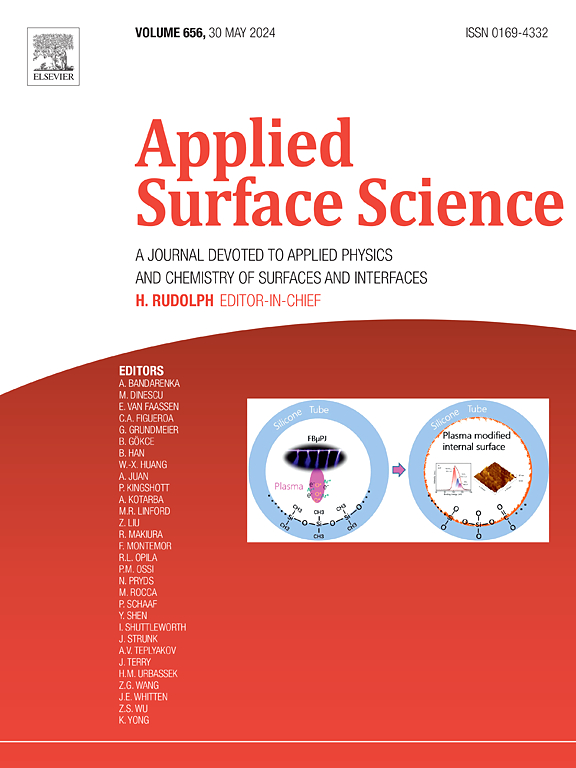利用银纳米团簇水凝胶原位合成分散良好的银纳米粒子,用于催化还原 4-硝基苯酚
IF 6.3
2区 材料科学
Q2 CHEMISTRY, PHYSICAL
引用次数: 0
摘要
在各种基质上方便、高效、稳定地固定金属纳米粒子是材料化学和异相催化领域的一个有趣课题。本研究报告了一种在室温下从银纳米团簇(Ag NCs)在水凝胶中原位合成和固定银纳米粒子(Ag NPs)的简便方法。Ag9-NCs((NH4)9[Ag9(mba)9],H2mba = 2-巯基苯甲酸)既是凝胶剂又是银源,与 Ba(NO3)2 结合构建水凝胶,而硼氢化钠(NaBH4)则是合成过程中的典型还原剂,可在原位生成 Ag NPs。因此,无需复杂的操作,就能方便地合成出平均直径为 1.96 nm 的 Ag NPs,并牢固地固定在 Ag9-NCs/Ba(NO3)2 水凝胶的纳米纤维上。伴随着还原过程,配位相互作用与氢键、π-π堆积和疏水相互作用相结合,推动了 Ag NPs/Ag9-NCs/Ba(NO3)2 的组装。此外,Ag NPs 在还原 4-硝基苯酚(4-NP)时表现出良好的催化活性,并且由于基于水凝胶的高稳定性,Ag NPs 易于回收和重复使用,可循环使用八次以上。这项工作为金属 NCs 提供了一种创新策略,可将其作为超分子组装模板和金属源用于原位制备金属纳米催化剂。本文章由计算机程序翻译,如有差异,请以英文原文为准。


In situ synthesis of well-dispersed silver nanoparticles from silver nanoclusters hydrogel for catalytic reduction of 4-Nitrophenol
Facile, efficient and steady immobilization of metal nanoparticles upon various matrixes is an interesting topic in materials chemistry and heterogeneous catalysis. This study reports a facile in situ method for the synthesis and immobilization of silver nanoparticles (Ag NPs) from silver nanoclusters (Ag NCs) in the hydrogel at room temperature. Ag9-NCs ((NH4)9[Ag9(mba)9], H2mba = 2-mercaptobenzoic acid) acted as both gelator and silver source which combined with Ba(NO3)2 to construct hydrogel while sodium borohydride (NaBH4) was used as a typical reductant during the synthesis process to generate Ag NPs in situ. As a result, Ag NPs with mean diameter of 1.96 nm were conveniently synthesized and firmly immobilized on the nanofibers of Ag9-NCs/Ba(NO3)2 hydrogel without sophisticated manipulation. Accompanied with the reduction process, the coordination interaction combined with the hydrogen bonding, π-π stacking and hydrophobic interactions drove the assembly of Ag NPs/Ag9-NCs/Ba(NO3)2. Moreover, the Ag NPs exhibited good catalytic activity toward the reduction of 4-nitrophenol (4-NP) and could be easily recovered and reused for more than eight cycles owing to the high stability based on hydrogel. This work provides an innovative strategy for metal NCs which could be highlighted as the promising candidates to be used as supramolecular assembly templates and metal sources for in situ preparation of metal nano-catalysts.
求助全文
通过发布文献求助,成功后即可免费获取论文全文。
去求助
来源期刊

Applied Surface Science
工程技术-材料科学:膜
CiteScore
12.50
自引率
7.50%
发文量
3393
审稿时长
67 days
期刊介绍:
Applied Surface Science covers topics contributing to a better understanding of surfaces, interfaces, nanostructures and their applications. The journal is concerned with scientific research on the atomic and molecular level of material properties determined with specific surface analytical techniques and/or computational methods, as well as the processing of such structures.
 求助内容:
求助内容: 应助结果提醒方式:
应助结果提醒方式:


